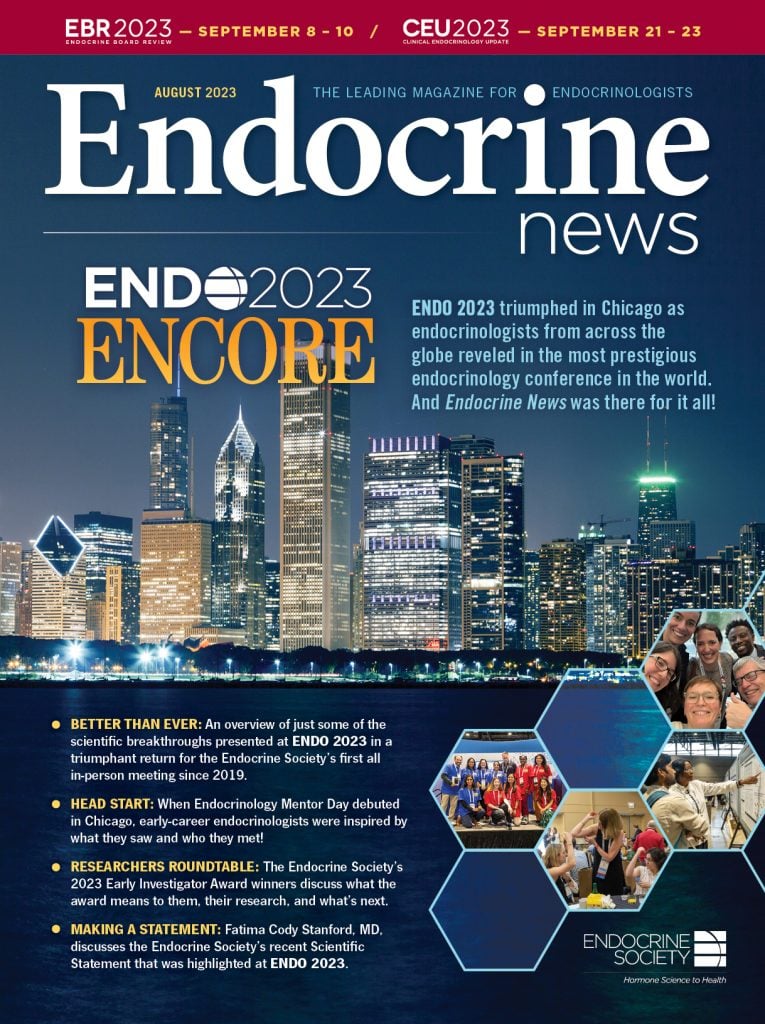
The Endocrine Society returns to Chicago for its first all in-person meeting since 2019.
Scientists and clinicians descended upon the Windy City in droves from near and far to take part in the biggest endocrinology meeting in the world. From the latest research to the newest patient therapies to networking with colleagues. or simply hugging longtime friends, ENDO 2023 turned out to be one of the most triumphant conferences in recent history.
In his 1914 poem, “Chicago,” Carl Sandburg called his adopted home the “City of Big Shoulders,” referring to those who built and rebuilt Chicago into the industrial center of the Midwest. According to Norman Corwin’s The World of Carl Sandburg, the poet described his work as “a chant in defiance by Chicago… its defiance of New York, Boston, Philadelphia, London, Paris, Berlin, and Rome. The poem sort of says ‘maybe we ain’t got culture but we’re eatin’ regular.”
And while modern Chicago certainly doesn’t lack culture – the city has inspired just as many works of literature, music, theater, and art as it has skyscrapers – the nickname “City of Big Shoulders” remains to this day, making it the perfect backdrop for ENDO 2023, four days when endocrinologists from around the world came together (finally, in person) to share the work that was inspired by the clinicians and researchers who came before them, work that will surely be carried on by the next generation.
Of course, while this piece will in no way do justice to the incredible depth and breadth of the program of the Endocrine Society’s annual meeting, Endocrine News hopes to offer a glimpse of the findings presented at McCormick Place in Chicago’s South Loop, from basic science and clinical updates to scientific statements reflecting on the current landscape of endocrinology and where to go from here, whose big shoulders to stand on.

The “Trickle Down” Effects of EDCs
In yet another indictment of endocrine-disrupting chemicals (EDCs), a rat study out of the University of Texas at Austin presented at ENDO 2023 showed that adverse cognitive effects linked to polychlorinated biphenyls (PCBs) exposure, a type of EDC, have the potential to be passed down through generations. PCBs can mimic the effect of estrogen on the body, contributing to a variety of neuroendocrine, metabolic, and reproductive problems.
PCBs were banned in the 1979 by the Toxic Substances Control Act (TSCA) but they remain in the environment and scale up the food chain – farmed fish and beef have high PCB concentrations, says Emily N. Hilz, PhD, a postdoctoral fellow in Andrea Gore’s laboratory at the University of Texas and first author of the abstract presented in Chicago.
The researchers write that in humans, PCBs are associated with sexually dimorphic and hormone sensitive neurobehavioral disorders including attention deficit hyperactivity disorder (ADHD) and mood disorders such as depression. Hilz says that through her previous research she came to believe that cognitive phenotypes like ADHD are organized early in life.
“I’ve always been interested in estrogen and its role in female cognition; some PCBs are estrogenic and have been in the environment for decades,” Hilz says. “This means we have multiple human generations that have been continually exposed in utero and early development. I thought there was a good chance this could at least partially explain the rise in ADHD and other cognitive disorder diagnoses we’re seeing contemporarily. This isn’t unique to PCBs – there are many estrogenic endocrine disruptors in the environment and in our products.”

For this study, the researchers administered a common PCB mixture called Aroclor 1221 to pregnant and nursing female rats. (The children and grandchildren were not given the chemicals.) The adults (n=40), their offspring (n=80), and their future grandchildren (n=80) were all tested on behavioral tasks to assess pleasure-seeking, attention, and cognitive flexibility. The team also took biological samples to determine what was happening physiologically to drive the behavior.
“Interestingly, we didn’t see changes until the grandchildren,” Hilz says. “Some in the endocrine community have expressed surprise that the children (exposed as a fetus) did not have behavioral differences, but my research is not the only study to find this ‘emerging phenotype,’ where we start seeing effects in grandchildren and even great grandchildren. This highlights something unique and perhaps nefarious about EDCs compared to more overtly toxic chemical compounds. It can take multiple generations to see the effects of EDCs, and I think that’s what we’re coming to face now.”
“The biggest misconception that I get when I talk to people about EDCs is that their personal care products are undergoing rigorous safety testing. That’s what I used to think too, but unfortunately that’s not the case especially when we’re talking about subtle effects emerging over generations. That type of thing isn’t being tested.” — Emily Hilz, PhD, postdoctoral researcher, University of Texas, Austin, Texas
Grandchildren of rats that were exposed to the PCB mixture were more interested in eating for pleasure, according to the results of the sucrose preference test. While all of the tested animals preferred the sucrose solution to water, the grandchildren of mothers exposed to the PCB mixture consumed more of the sucrose solution.
“This might be analogous to an increased likelihood to overeat, as many EDCs are obesogens and it is possible that eating for pleasure could represent a behavioral aspect of metabolic disruption by PCBs,” Hilz says. “Alternatively, or additionally, this may represent an increased likelihood of developing a substance use disorder.”
The same rats had an impaired ability to switch between tasks or learn new rules. However, only the male grandchildren were more likely to become fixated with a visual cue, which is common in disorders such as ADHD. “Many people with ADHD often have comorbidities with depression and self-medicate with substances of abuse,” Hilz says. “In rats it’s hard to say based only on sucrose preference whether this is a caloric thing or a pleasure thing, so we’re following the result up in a new study looking at EDC mixtures.”

Hilz says that this study is only a drop in the bucket adding fuel to the connections between EDCs and adverse health outcomes that emerge over generations, and that what it really highlights is that current toxicological screening techniques are not adequate for assessing EDC-like effects where the initial exposure occurs far away in time or even generations apart from the adverse health impact, or results from an extremely small exposure occurring during a developmentally sensitive time. “The endocrine community has been drawing a lot of attention to this issue and I think we’re going to be seeing some big changes in the next decade regarding chemical manufacturing and safety testing,” she says.
“The biggest misconception that I get when I talk to people about EDCs is that their personal care products are undergoing rigorous safety testing,” Hilz continues. “That’s what I used to think too, but unfortunately that’s not the case especially when we’re talking about subtle effects emerging over generations. That type of thing isn’t being tested. EDCs are real and contribute to current health epidemics we’re seeing – not just in cognitive science, but in reproductive and metabolic realms as well.”

Can Obesity Remedies Impact Wrist Fractures?
As the obesity epidemic continues its upward march and bariatric surgery is becoming an option for more patients, one study presented at ENDO 2023 looked at these procedures’ effects on bone health. In an oral abstract session on bone strength and fracture risk, Bita Zahedi, MD, a clinical practitioner at Massachusetts General Hospital in Boston, shared her findings, titled, “Risk of Wrist Fracture in Gastric Bypass Compared to Gastric Banding as Estimated by the Load-to-Strength Ratio,” during which she described how Roux-en-Y gastric bypass (RYGB) and adjustable gastric banding (AGB) both decrease weight, but they both lead to long-term deficits in bone density. “Given that risk of fracture is dependent on both bone strength and the external force applied to bone, the clinical implications of these opposing effects are unclear,” Zahedi and her colleagues write. “The aim of this study is to compare the long-term skeletal impact of RYGB and AGB using a biomechanical evaluation of load-to-strength ratio as a surrogate for fracture risk.”
“These two bariatric procedures are different in that RYGB is a metabolic surgery while AGB is a purely restrictive procedure.” Zahedi says. “Population-based retrospective analyses have shown an increase in fracture rates when comparing the Roux-en-Y patients to the gastric banding patients, in the short term. Although short-term bone loss has been demonstrated to be greater in the Roux-en-Y group, data regarding long-term effects on bone health and fracture risk is limited.”
“This highlights that there are long-term deleterious skeletal effects which are more concerning in Roux-en-Y compared to gastric banding, which is in alignment with cross-sectional population-based studies evaluating fracture rates at the wrist.” — Bita Zahedi, MD, clinical practitioner, Massachusetts General Hospital, Boston, Mass.
Zahedi further explains that the results of this study expand on existing data that suggest mechanical unloading after weight loss surgery does not fully explain the extent of observed deficits in bone density, especially at non-load-bearing sites such as the wrist.

For this cross-sectional study, the researchers analyzed data from a cohort of 25 subjects who had RYGB surgery more than 10 years prior and compared that to data from another 25 individuals who had undergone gastric banding more than 10 years before. They did imaging to estimate load-to-strength ratio and analyzed body composition with DXA. They used high-resolution peripheral quantitative computed tomography (HR-pQCT) to measure volumetric bone mineral density, geometry and microarchitecture at the wrist. Results were then adjusted for age, sex/menopausal status, and race/ ethnicity.
Participant characteristics showed that BMI in the AGB group tended to be higher than the RYGB group, although this did not reach statistical significance. Serum calcium was similar in both groups, while the RYGB patients tended to have lower vitamin D and higher PTH levels; Both groups had greater than sufficient vitamin D, and even though there was a trend towards higher PTH in the RYGB group, neither PTH nor vitamin D levels reached statistical significance. Nonetheless, sensitivity analyses were run to account for these two factors which did not alter our results.”
The researchers next looked at DXA Z-scores (which already account for sex, age, and race) and found that although the RYGB cohort had slightly negative Z-scores at the femoral neck and total hip, the AGB group had positive Z-scores at the femoral neck, total hip, spine and the wrist. “These were all statistically significant and showed that the gastric banding participants when compared to RYGB group had higher areal bone mineral density at the femoral neck, total hip and spine” Zahedi says.
The HR-pQCT data gave the team insight as to the volumetric bone mineral density (BMD), the microarchitecture and geometry at the wrist. The results showed that total volumetric BMD, as well as trabecular and cortical vBMD were greater in the AGB group; the geometry and microarchitecture showed greater deficits in the RYGB group particularly in evaluation of trabecular parameters. Estimated impact force was similar in both groups, although bone strength at the wrist was higher in the AGB group when compared to the RYGB cohort. Numerically, the load-to-strength ratio was greater in the RYGB group consistent with a higher risk of fracture at the wrist when compared to AGB, although this did not reach statistical significance. Zahedi says that other studies using this biomechanical measurement have used a threshold of greater than 0.75 to signify as high risk of fracture. If this threshold is used, we can appreciate that RYGB group had a load-to-strength ratio of 0.824 and AGB 0.728 with the latter being at lower risk of fracture at the wrist.”
Zahedi notes that in summary “we found that the Roux-en-Y group had lower volumetric BMD, lower strength at the radius, and worse trabecular morphology and architecture. RYGB cohort also showed a trend toward a higher load-to-strength ratio, consistent with a higher fracture risk at the wrist, although the latter was not statistically significant” Zahedi says. “This highlights that there are long-term deleterious skeletal effects which are more concerning in Roux-en-Y compared to gastric banding, which is in alignment with cross-sectional population-based studies evaluating fracture rates at the wrist.”
Zahedi says that during her oral presentation at ENDO 2023 she fielded a lot of thoughtful questions that helped guide her and her team in exploring the underlying mechanisms leading to bone loss in patients that have undergone bariatric surgery. Future studies are needed to evaluate the underlying pathophysiological mechanisms of these skeletal impacts in order to help determine clinical strategies to minimize bone loss post bariatric surgery.

Endocrine Society Statement Examines Hormones and Aging
A new Scientific Statement released during ENDO 2023 highlights the differences between aspects of aging that are normal and sometimes over-treated, and those such as menopausal symptoms and osteoporosis that can be treated and deserve more attention.
“Hormones and Aging: An Endocrine Society Scientific Statement,”reviews the current state of research on hormonal changes with age. The statement focuses on common endocrine-related changes in older people including menopause and the development of diabetes, osteoporosis, and thyroid disorders, with the goal of informing future research on the prevention and treatment of age-associated endocrine health problems. “The extent to which hormonal changes with age are deemed ‘normal aging’ versus ‘endocrine disease’ can be arbitrary and depends in part on whether treatment is currently indicated,” the Statement authors write. “Four hypothalamic-pituitary axes are presented: growth hormone, adrenal, gonadal (divided into ovarian and testicular), and thyroid. These are followed by osteoporosis, vitamin D deficiency, diabetes, and water metabolism topics.”
“We wanted to look at a number of hormonal changes that occur with age, so that is why have nine separate sections representing nine different areas,” says writing group chair Anne Cappola, MD, of the Perelman School of Medicine at the University of Pennsylvania in Philadelphia, Penn. “Our goal was to present the research on aging that has already been performed and identify where we think new research should be going.”
“We need to be able to understand where the identification and management of endocrine disease is the same in older as in younger people and where it is different since we will be encountering an increasing number of older patients in our practice.” — Anne Cappola, MD, Perelman School of Medicine, University of Pennsylvania, Philadelphia
Key points from the statement include:
- Menopausal symptoms are common, vary in degree of discomfort and can be effectively treated with a variety of medications, yet these symptoms are still undertreated.
- More research is needed to decide when older adults should receive testosterone-replacement therapy and to understand the adverse effects of the treatment on heart and prostate disease.
- More data is needed to determine the optimal treatment goals in older people with diabetes.
- Fractures are often not recognized as being related to osteoporosis, and as a result, most older patients with a fracture are not treated to prevent their next fracture.
- Methods to distinguish between age-associated changes in thyroid function and early hypothyroidism are needed.
- No therapy to increase growth hormone secretion or action is currently approved as an anti-aging intervention, and the risks may outweigh the benefits.
- Some research has shown benefits of vitamin D supplementation in older adults, but standardized guidelines on appropriate vitamin D levels are lacking.

The authors of the Statement point out that this area will only expand in importance as the number of older individuals increases worldwide. “Current projections show an increase in those aged 65 years and older from 703 million (1 in 11 people) to 1.5 billion in 2050 (1 in 6 people),” they write.
“We need to be able to understand where the identification and management of endocrine disease is the same in older as in younger people and where it is different since we will be encountering an increasing number of older patients in our practice,” Cappola says.
Cappola says that one important aspect of this Statement is to reinforce what the endocrinology community already knows, as well as point to what can be done as the community moves forward. For example, the Statement authors write that existing knowledge of hormones and aging is largely based on results of observational and uncontrolled studies. “We need randomized clinical trials to be able to provide the highest level of evidence,” Cappola says.
“The Statement discusses how menopausal symptoms and osteoporosis are often undertreated in the older population despite evidence that the treatments are both safe and effective,” Cappola says. “Treating these symptoms and screening for common endocrine conditions that develop or worsen with age could really improve the quality of life for older people.
“This statement is a one-stop place to get a brief summary of each of nine hormonal areas and understand what is already known and what is unknown,” she continues. “We had fantastic articles, so it is a really readable piece.”

And again, there’s no way we could fit all the incredible things that happened in the McCormick Center into these pages – but it’s never bad to have too much of a good thing. By all accounts, the return to Chicago was a triumph.
“From my perspective, ENDO2023 was a huge success,” says Stephen R. Hammes, MD, PhD the Louis S. Wolk Distinguished Professor of Medicine, chief of the Division of Endocrinology, Diabetes and Metabolism, executive vice-chair of the Department of Medicine at the University of Rochester in Rochester, N.Y., and new Endocrine Society president. “I could go on about the great plenary talks, the amazing symposia, and the informative Meet the Professor sessions, but, to me, the best thing was to see everybody back together again both in person and in full force.”
Hammes adds that he especially enjoyed the lively and interactive oral, poster, and rising star sessions, all of which featured the up-and-coming generation of endocrinologists. “I am looking forward to seeing more of the same in Boston next year, including the continued focus on the pipeline and our early-career members,” he says. “Our members are an amazing group of diverse individuals, and, when we are all together, great things will happen!”
Bagley is the senior editor of Endocrine News. He wrote about a new approach to treating hypothyroidism in the July issue.

